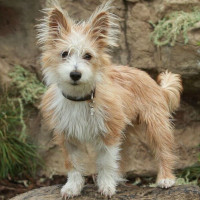Appearance of the Yorkeltie
|
| The Yorkeltie has a long, luxuriant double coat with a slightly wiry texture. It comes in shades of black, brown and white. Its ears resemble those of the Sheltie, but on rare occasions, some specimens have completely upright ears. Its face resembles that of a fox, with a long nose and plunging forehead. The overall appearance of this fluffy dog is elegant. Its bone structure tends to be delicate and refined. Its paws are tiny and cat-like. The dog has a modestly long, fur-covered tail that can be carried straight. Its gait is robust and purposeful. |
Temperament of the Yorkeltie
|
| The Yorkeltie is a loving, affectionate dog. He loves nothing better than to be by his family's side every day. Unlike many dogs who are independent by nature, he prefers to please his master and spend every waking minute as a companion. His alertness, intelligence and love of play make him an ideal family pet. He'll be happy living in an apartment, provided he gets enough exercise every day. He gets on well with other dogs, but as with all dogs, regular socialization is essential. Obedience training and visits to the dog park will provide him with many healthy interactions. |
Needs and activities of the Yorkeltie
|
| The Yorkeltie is an active breed that needs exercise. A daily walk and some playtime are usually enough to meet their needs. They often have a strong herding instinct, inherited from the Sheltie. Their herding instinct often manifests itself in the presence of young children or other pets. This breed's quick intelligence makes it an excellent choice for obedience, flyball or agility. He loves to learn new things and is happiest when working alongside his beloved master. He'll also be happiest if he spends enough time outdoors, so make sure you devote time to him every day. |
Maintenance of the Yorkeltie
|
| Daily brushing is essential to keep the Yorkeltie's coat tangle-free. It has a very thick undercoat that it blows out twice a year, allowing it to produce a lot of excess fur. In general, he needs a bath once a month to keep his coat in tip-top shape. Brushing his teeth several times a week helps prevent doggy breath and remove plaque. His active lifestyle naturally wears down his nails, but if this is not the case, it may be necessary to trim them. His upright ears may contain dirt and debris in the flaps, so wiping them with a washcloth will help keep them clean. |









 English (United Kingdom)
English (United Kingdom)